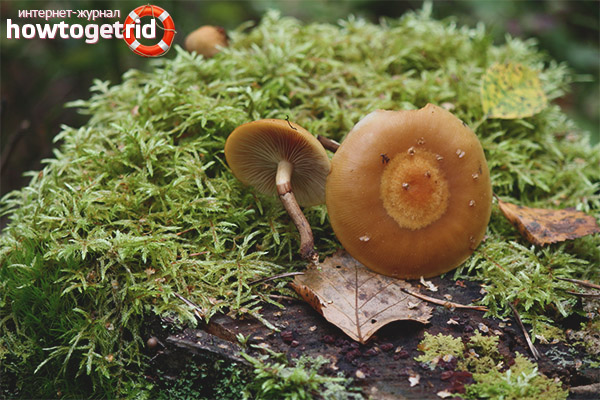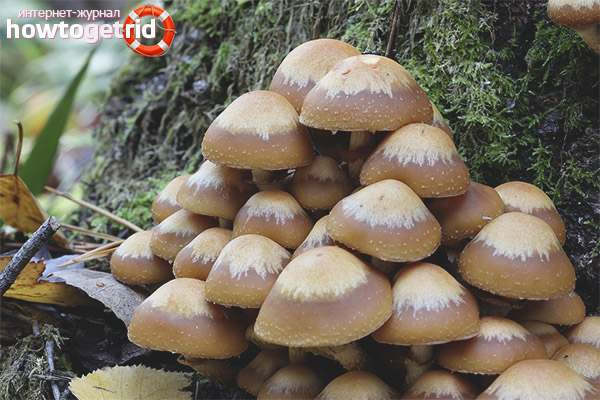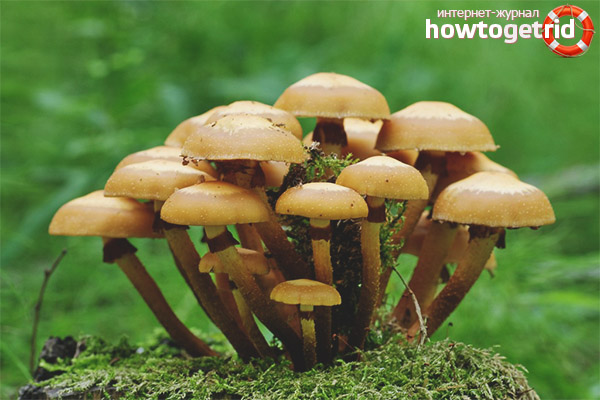The content of the article
Summer honey mushrooms are common mushrooms of the stropharia family, they are known to a wide circle of inhabitants under such names as talkers.
This species has the following characteristic features that distinguish it from others:
- The cap of the fungus at the beginning of its growth has a slightly convex shape, in adult specimens it is convex-prostrate, with a dull tubercle in the center. The maximum dimensions of this part of the honey agaric are up to 6 cm in diameter. The color is brown, the color intensity directly depends on weather conditions - it fades in dry weather, after precipitation the color becomes more saturated.
- Descending plates are rare, adhered to the hat; the color of the plates is brown. The debate is dark.
- The leg of the honey agaric is brown, the surface is fibrous, the shape is cylindrical, tapering at the base. The legs of honey agarics reach a height of 80 mm, not more than 1 cm in thickness. It has a characteristic ring of brown color, the lower part of the leg is covered with small scales.
- The pulp of the fruiting body is light brown, quite thin with a watery structure, the aroma is pleasant - woody, the taste is delicate.
Distribution and collection
In fact, this fungus leads a parasitic lifestyle, the fruit bodies of the honey agaric affect several trees at the same time. At the same time, the latter can be of different types (milky coating). Most often, large clusters of talkers grow in hard-to-reach places.
Note that in areas with a fairly mild climate, fruiting of lime tree honey is observed almost all year round.
Similar species
To date, it is known about several types of mushrooms, which, although similar in appearance to honey agaric, are nevertheless inedible and dangerous to human health and life. Moreover, they coincide not only the growing conditions, but also the fruiting season.
- Galerine skirted - a very dangerous, poisonous mushroom, which at first glance looks almost the same as a talker. Nevertheless, having met such a gift of nature in the forest, it can be distinguished from an edible mushroom by some characteristic signs. The galley's hat with a border is ocher-red in color, the leg is fibrous with a yellow ring, and there are no scales at the base. The smell is specific - flour. This mushroom, unlike honey agarics, does not form splices, grows heaped, but one by one. Most often, this type of mushroom is found in coniferous forests.
- Sulfur yellow false honey agaric. The main color of this poisonous species of mushrooms is yellow with a characteristic grayish tint, the hat has a red-brown top, and the plates are dark olive. There is no ring on the leg. This inedible mushroom grows in small colonies, the fruiting season is from July to the first frosts. The shape of a bell-shaped hat with open edges. The pulp is light with a yellowish tinge, has an unpleasant odor and a very bitter taste. The spores are brown.
- The red-brick false foam differs from its edible counterpart in saturated orange-red color, bitter flesh of a yellowish color and a leg without a ring. This species grows in small groups, the main fruiting period is from July to early November.The shape of the hat is round-convex, with outstretched edges, the central part is painted in a darker color. The pulp of the fruiting body is fleshy. Spores are purplish brown. The leg is narrowed at the base, the ring is absent.
- Seroplate False Foam is one of the few species of fungi that is an edible relative of govorushki. The mushroom cap is yellowish brown with a characteristic darkening in the center. The color of the lamellar structure depends on the maturation of the spores.
- Psatirella Candolla is a conditionally poisonous variety of mushrooms that grow in fairly large groups from late spring to mid-autumn. The shape of the hat is bell-shaped, the edges are wavy-sinuous. The surface of the cap is almost smooth, there are small scales, the color is from a yellowish brown to saturated brown. The white flesh of the mushroom is very fragile, with a characteristic pronounced mushroom aroma and taste. Leg, thickened at the very base, the color is more cream. Spore powder has a brownish tint.
- Psatirella is water-loving - a poisonous mushroom; the fruiting season is autumn. Grows in small splices or groups. The shape of the cap, like in many inedible species, is bell-shaped; the skin of the fruit body has a dark brown or brown-yellow color. The center of the cap has a slight bulge, the edges are cracked. The brown flesh of the mushroom is quite thin, the structure is watery, the taste is bitter. The leg of such a mushroom-like look is hollow inside, the surface is smooth, brown.
Processing and preparation: what is important to consider?

Govorushka is a delicious edible mushroom, the preparation of which does not require mandatory preliminary heat treatment (boiling is meant). To prepare this type of natural gifts, you should first clean the mushrooms from leaves, blades of grass, and rinse well. After this, honey mushrooms can be cooked in one of the selected ways (fry, stew, marinate).
Also, talkers are often dried. If this type of processing of mushrooms is selected, then they should not be washed first. As a rule, aromatic mushroom powder is made from dried linden mushrooms, which is an excellent flavoring agent for a variety of soups, gravy, sauces and other culinary dishes.
Growing
Today, many of our compatriots are engaged in the cultivation of summer mushrooms in their local area, an important condition for the growth of these mushrooms is the presence of several stumps on the site. Inoculation is carried out by carefully transferring several sections of wood infected with mycelium for subsequent introduction into pre-made holes in the stumps (up to 0.8 cm in diameter). After the mycelium is placed in the holes, it is covered with moss. The best time to infect stump wood with mycelium of honey is spring or autumn. The duration of fruiting of such a mushroom plantation is about 7-8 years.
Caring for a home mushroom plantation does not require special requirements, the most important thing is to provide effective protection from direct sunlight, and the necessary humidity level for the full development and growth of honey agarics.
Video: honey agaric (Kuehneromyces mutabilis)











Submit